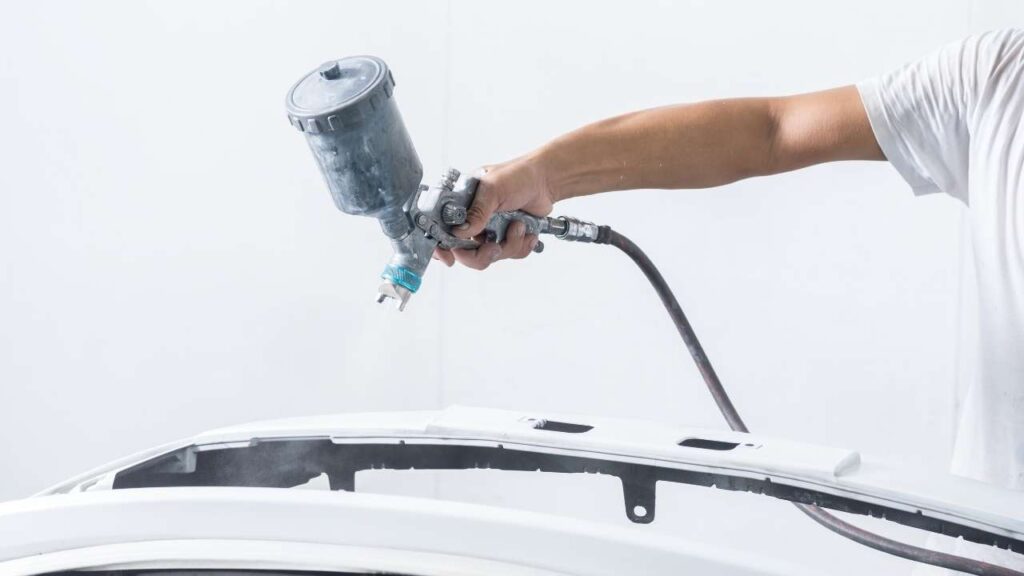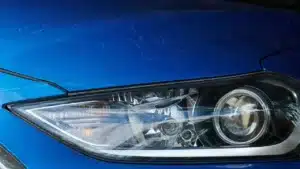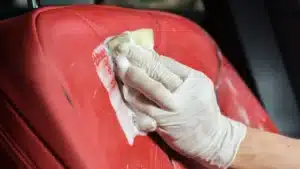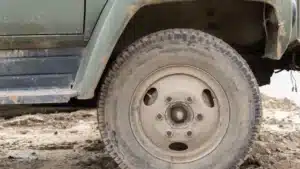You can save money by painting plastic bumpers yourself rather than hiring someone else to do the job. With the correct materials and processes, you can complete the job in a day or two.
You need to understand, however, that painting the plastic on your vehicle is very different from painting metal parts.
For instance, plastic has an increased sensitivity to chemicals, and paints that work on car bodies may not adhere to plastic or provide the expected color once dry. Read more about How to paint plastic car parts
Because of these concerns, you must be sure you have the right materials and follow the correct preparation and application steps for painting bumper plastic.

How to Paint Plastic Car Bumper
Materials Needed to Paint Bumper Plastic
Here are the tools and products you need to ensure you prepare the surface properly and apply the paint correctly so it dries to the expected color and adheres to the plastic.
- Adhesion promoter and primer to ensure the paint sticks;
- Painter’s tape to protect the areas around the bumper from paint splatter;
- Spray paint cans with paint that adheres to plastic;
- Clear coat to cover the final product;
- Soft cloth or sponge to wash and dry the plastic before painting;
- Bucket of soapy water for washing;
- Fine-grain sandpaper to prep the surface;
- Mask to use during sanding and painting;
- Gloves to protect against paint splatter;
- Well-ventilated garage or outdoor location to protect your respiratory system from paint inhalation.
Once you have these materials, you can begin preparing new plastic bumper for paint.
Steps for Preparing New Plastic Bumper for Paint
Before painting a front bumper, you need to prepare the surface. The following steps ensure an even coat and proper adherence.
- Prepare a garage or outdoor painting location. Spray paint can cause significant air pollution, so it is best to work in a well-ventilated garage or a dry, protected outdoor location.
- Remove the plastic car bumper. If possible, remove the car bumper to enable you to thoroughly clean and prepare it for painting. This will also help you avoid paint splatter on the car body.
- Clean the surface. The next step is to thoroughly clean the surface of your plastic bumper. Wash your bumper with car wash detergent and scrub it to ensure all the dirt or debris is removed, then rinse with water and allow it to dry.
- Sand glossy surfaces. Paint adheres far better to rougher matte plastics than on glossy surfaces. Therefore, the next step is to lightly sand all the surfaces of your bumper with 220-grit or higher sandpaper. You can sand by hand to prevent deep scratches. Read more about how to remove paint from plastic car parts
- Wipe with mineral spirit. Finally, clean your plastic bumper with mineral spirit to remove the fine plastic dust produced by sanding. You can also use compressed air for this step if you have it available.
Once the preparation is over, it’s time to focus on the painting bumper with spray can process.
Steps for Painting a Plastic Bumper
Once the surface of the bumper is prepared for painting, it is time to apply the color. In addition to the steps for applying paint and primer, you should be aware of proper safety techniques. For example, you should wear a protective mask when painting to avoid inhaling the fumes.
Once you’ve accounted for safety, you can begin the steps for painting bumper plastic.
- Apply painter’s tape. Inspect your car bumper and apply the painter’s tape over the sections that don’t need to be painted or the sections adjacent to the bumper if it is still attached to the car.
- Apply adhesion promoter. Plastic is not porous and in most instances, the paint will slide down or bubble on the surface as you apply. To prevent this from happening, first, use a thin coat of adhesion promoter.
- Apply primer. Next, apply two or three thin coats of primer on your plastic bumper surface. The best strategy is to let the primer dry for three minutes between coats and 10 to 20 minutes before applying paint.
- Apply the paint in multiple coats. Once the primer is properly dried, it is now time to apply the paint. Apply three even coats of paint on the car bumper. Again, the most effective timing is to paint one coat every 10-20 minutes to allow for adequate drying.
Spraying too close to the surface can lead to uneven paint layers. Whenever you are applying the primer or paint, ensure the spray can is 6 to 8 inches away from the surface. This will also help avoid splashback.

Follow the Correct Process for Painting a Front Bumper
Painting plastic bumpers can be challenging. Because plastic is a unique surface in terms of paint adherence, preparation is extremely important. However, if you select the correct paint and closely follow the process for preparing and applying the color, you can succeed with the project and have a car with a perfectly painted bumper.
FAQs
How Do You Paint a Plastic Bumper with Spray Cans?
In most cases, painting bumper with spray can paint is the best option. If you follow all the preparation steps and hold the can 6 to 8 inches away from the surface, you will get nice, even coats. Remember to let the paint dry for 15 to 20 minutes between coats.
How Much Does It Cost to Have a Bumper Painted?
In most instances, the average cost of painting or repainting your plastic car bumper in a shop is around $500. This will include the prep work, cost of paint, and labor. Typically, the exact price will depend on the size of your car’s bumper.
Painting plastic bumper parts yourself is more economical. You may be able to complete the project for $100 or less, depending on the materials that you already have on hand. Even if you must purchase sandpaper, car detergent, and safety gear, it will still be significantly cheaper to paint the bumper yourself.
What is the Best Spray Paint for Plastic Bumpers?
There is a wide range of spray paints for plastic car bumpers and choosing the best option may prove challenging. However, here are three good options.
- Dupli-Color Trim and Bumper. This spray paint is meant for plastic surfaces, and it also has superior adhesion. It dries to the touch in about 30 minutes, so you will be ready to go quickly after the project is done.
- Eastwood Plastic Resurfacer Aerosol Paint. This is another good spray paint for plastic surfaces. It can permanently restore automotive plastics and guarantees 7 years of UV resistance.
- Seymour 20-1679 PBE Professional Trim Spray Paint. This paint is not only heat resistant up to 250˚F, but it can also withstand fading from UV light and degradation from chemicals.
Do Plastic Bumpers Need a Primer?
While primers are generally only needed for refinishing or repairing plastic bumpers, they can help with color and adherence. Because plastics are typically non-porous, primers will often be used together or interchangeably with adhesion promoters to allow for better adherence to the plastic surface.
How Many Spray Cans Do I Need to Paint a Bumper?
On average, it will take about 4 to 5 cans to paint a bumper. However, the number will vary depending on the size of the bumper and how many coats you use.
Related Content:



